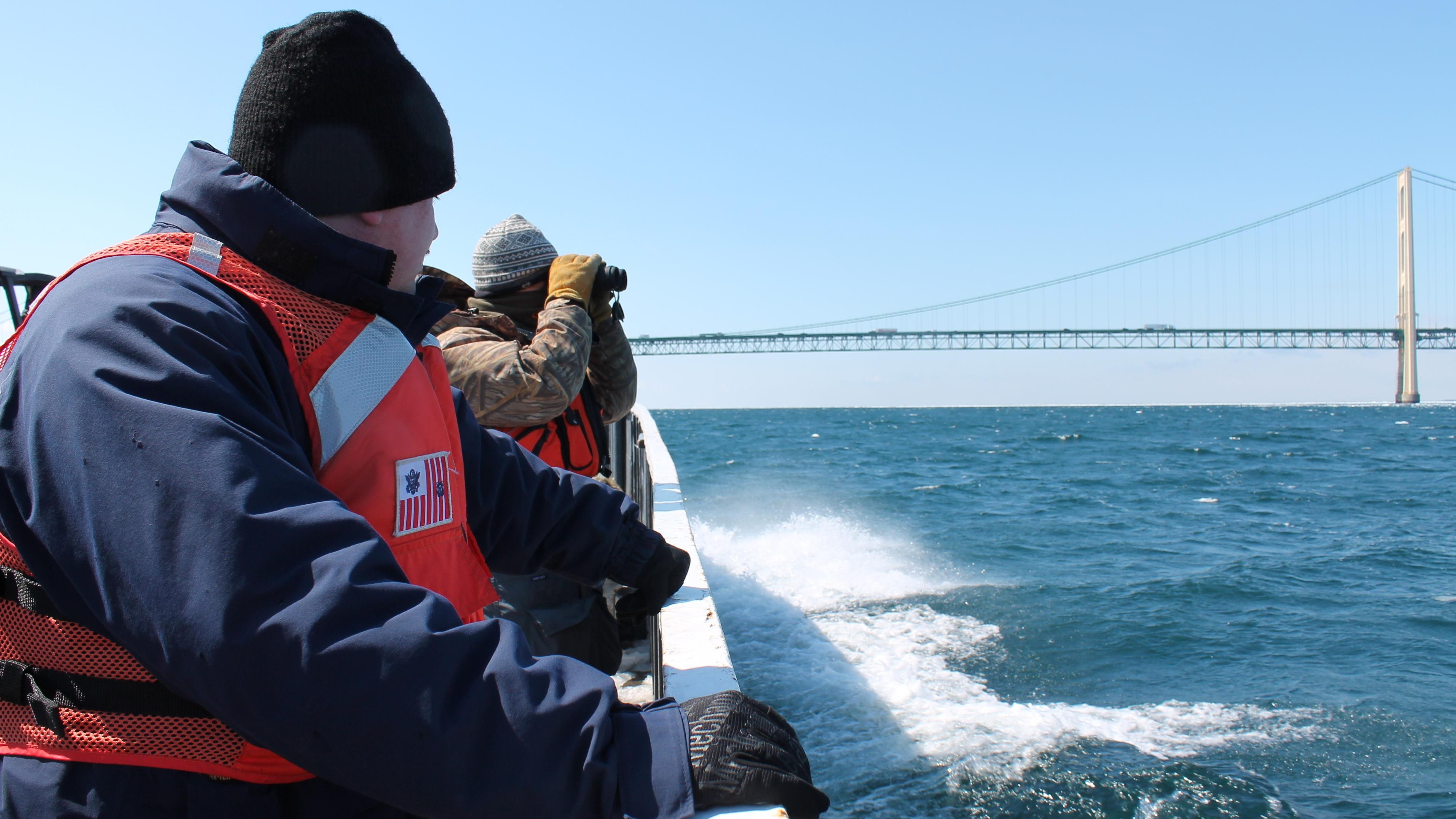Line 5 tunnel talks set to gain steam
 Jonathan Oosting
Jonathan OostingLansing – Michigan Gov. Rick Snyder’s administration is in talks with Enbridge Energy Inc. and other companies to build a shared utility corridor beneath the Straits of Mackinac that could house a replacement Line 5 oil pipeline and other infrastructure.

Discussions are ongoing and should pick up steam in coming weeks when the Canadian energy company files required reports to the state, including an evaluation of alternatives to its aging and controversial dual pipelines, Snyder spokesman Ari Adler said Monday.
“I don’t think negotiations is the right word,” Adler told The Detroit News, “but the idea would be: When you look at some sort of a corridor or a tunnel with Line 5, would it make sense to put other cables and pipelines under there as well?”
In a report due June 15, Enbridge is expected to tell the state that a tunnel is a “feasible” option for replacing Line 5, according to two sources familiar with the findings.
The analysis is likely to bolster Snyder’s push for a utility corridor that could include other infrastructure currently sitting on the lake bed, including electric transmission cables damaged by an anchor strike in early April and separate natural gas pipelines.
Snyder said almost two months ago he wants Enbridge to decommission Line 5 and construct a tunneled replacement if studies show the tunnel could be built and wouldn’t cause “significant environmental damage.”
The aging dual pipelines, built in 1953, transport up to 540,000 barrels a day of light crude oil and natural gas liquids through the Straits, a turbulent waterway that connects Lake Michigan and Lake Huron.
Michigan House Speaker Tom Leonard, R-DeWitt, told The News the Snyder administration is working on “a deal to finally put this issue behind us and ensure that our Great Lakes are protected.”
“It’ll be good news from the citizens of this state,” Leonard said during an interview last week about a recent budget agreement that will see the state set aside reserve funding that could be used for a multi-year Line 5 transition.
Snyder’s office said it is not planning any major announcement to coincide with the release of reports Enbridge must submit this month as part of a November 2017 agreement with the state, including two additional analyses.
Snyder and Enbridge Vice President of U.S. Operations Bradley Shamla also agreed to initiate further negotiations when the company files its reports, with the goal of finalizing any additional Line 5 agreement by Aug. 15.
Snyder sets deadline
The governor made clear at last week’s Mackinac Policy Conference he wants Line 5 “and potentially other items” off the lake bed and is working to finalize plans before he leaves office at the end of the year.
“Having a pipeline on the bottom of the Great Lakes is not a great long-term solution,” Snyder told reporters on the porch of the Grand Hotel, which overlooks the Straits. “We’re at risk, so how you do you take it where you remove that risk?”
Environmental activists have long called for a Line 5 shutdown, warning an accident like Enbridge’s massive 2010 Kalamazoo River oil spill could devastate the Great Lakes. But state and industry officials have warned that complete shutdown would cut off a supply of propane that many Upper Peninsula residents rely on for heat.
Snyder publicly backed the tunnel option in April after a ship’s anchor dented the Enbridge pipeline and ruptured transmission cables owned by American Transmission Company of Wisconsin, which leaked 600 gallons of dielectric fluid containing mineral oil and benzene.
TransCanada’s Great Lakes Transmission Company also operates two natural gas pipelines that run along the bottom of the Straits. AT&T has a fiber optic cable on the lake bed that helps serve customers in the Upper Peninsula, a company spokesman said.
A tunnel could house more than just the Enbridge pipeline replacement, Lt. Gov. Brian Calley said last week, noting the potential for “cooperatives of some sort” involving several firms.
“You could have a tunnel that is shared by multiple entities, so you could get everything off the lake bed, and maybe that would make it more feasible,” Calley told The News.
“Those sorts of discussions are interesting, but ultimately … the main risk that was identified in our own investigation was an anchor strike. Putting the line in a tunnel 50 to 100 feet below the lake bed eliminates that risk.”
Constructing a utility corridor beneath the lake bed could cost more than a half billion dollars and take up to seven years to complete, according to recent projections from student researchers at Michigan Technological University.
Foes oppose tunnel
That timeline does not account for the dozens of state and federal permits for which Enbridge would have to apply, said Sean McBrearty of Oil and Water Don’t Mix, which favors decommission and opposes tunnel construction.
“We’re talking a process of about seven to 10 years, at least, where Line 5 would still be in operation as a major threat to the Great Lakes while they build this,” McBrearty said. “And they’re still not removing the threat, just enclosing it. Nobody knows how much more difficult it might be to respond to an oil spill under those conditions.”
Michigan lawmakers recently agreed to set aside several million dollars in reserve funding that could be spent on new protective efforts while a tunnel is built, but the state should not pay for construction, Calley said.
“When it comes to protection of our natural resources, that’s a responsibility of the state,” he said. “The owners of the line need to cover the cost.”
Enbridge’s June 15 alternatives report must include an assessment of potential costs, engineering consideration and environmental impacts of moving Line 5 into a tunnel, threading it underneath the ground through horizontal directional drilling or into a trench using an open-cut method with secondary containment.
“I can’t get out ahead of the report going to the state quite yet, but we’re looking at the tunnel option,” said Enbridge spokesman Ryan Duffy. “It looks like a good option, and the trench option looks like a good option.”
Calley said a tunnel is preferable to a trench because it would allow for visual inspections.
The 2019 budget includes $82 million in reserve funding, but Snyder and state lawmakers said last week that $50 million of that reserve aid will be used in an attempt to coax the federal government to fund long-discussed Soo Locks upgrades. The other $32 million could be spent on projects related to Line 5 or efforts to fight Asian carp.
ATC, which owns underwater electric transmission lines that connect the Upper Peninsula to lower Michigan, is moving forward with plans to replace existing cables with two new power lines that will use “solid dielectric insulation” rather than the kind of fluid that leaked into Straits after the April anchor strike, said spokeswoman Jackie Olson.
The new circuits could be in service by late 2021 pending certification by the Midcontinent Independent System Operator organization and would require permits from the Michigan Department of Environmental Quality and the Army Corps of Engineers.
“While we are always open to talk about infrastructure needs with our utility colleagues, a tunnel proposal would take years to design, permit and build,” Olson said. “Using a solid dielectric insulation will eliminate the chance for a future spill. We are proceeding now because we have a responsibility to maintain electric reliability in Michigan.”
TransCanada did not respond to a Monday inquiry about the possibility of moving its natural gas pipelines to a shared utility tunnel.
Other energy delivery options
Rather than leave Line 5 under the straits, Line 5 opponent McBearty said Michigan should consider other energy transmission options for getting propane to the Upper Peninsula and transporting light crude produced in the northern Lower Peninsula.
A report released at the Mackinac conference last week by the Great Lakes Business Network highlighted the potential for a 4-inch propane pipeline from Wisconsin that would end at a refinery in Rapid River, Michigan, without continuing to the straits.
“The problem is having an oil pipeline running through the Straits of Mackinac,” McBearty said. “Whether or not it’s in a tunnel, it presents a threat to the most sensitive part of the Great Lakes ecosystem.”
In addition to the Line 5 alternatives assessment due June 15, Enbridge is expected to file reports to the state by month's end evaluating measures to mitigate anchor strikes, and develop underwater technologies to enhance leak detection and assess pipeline coating.
Snyder issued an emergency order last month prohibiting ships from dropping or using anchors in the Straits of Mackinac except in cases of emergency or with prior written permission.
The reserved state funding could be used supplement those efforts while a tunnel is constructed, the governor suggested last week.
“I don’t want to create a lot of speculation,” Snyder told reporters, “but there are automated systems to communicate to ships to say you’re approaching this area, do you have your anchor up?”
The reserve funding could also be used for independent research after Enbridge submits its reports to the state, Calley said.
“To the extent there’s additional questions, there could be additional expertise we need to bring to the table to understand,” he said. “We take a position that we can’t really afford to trust anybody else on this. We really need to know for ourselves what the best option is or the best options are.”
joosting@detroitnews.com